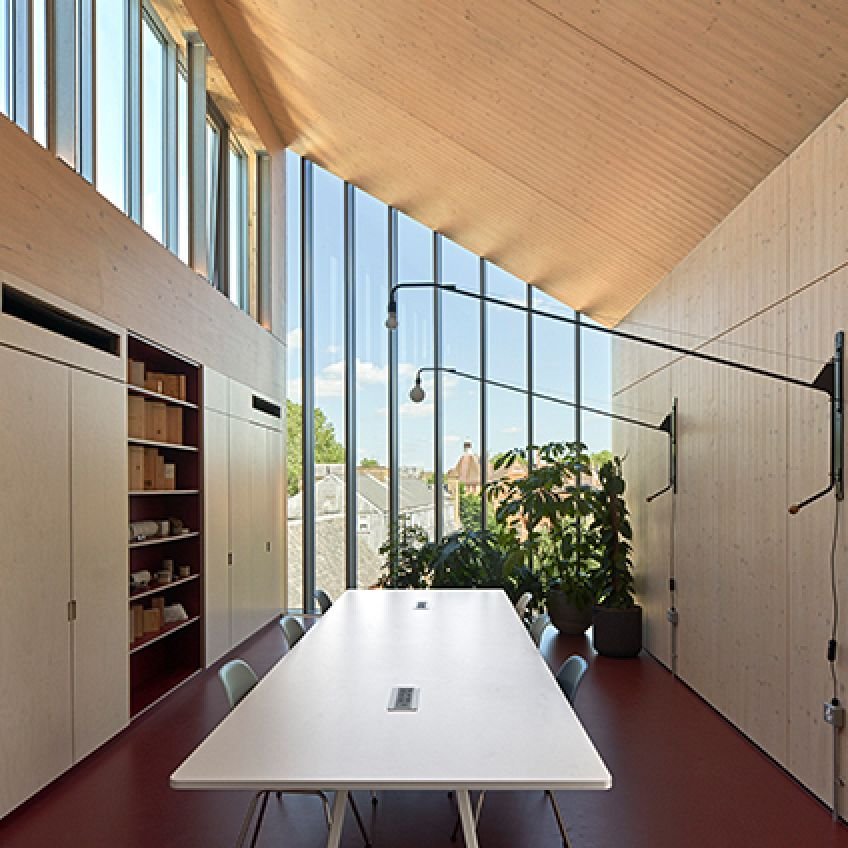The use of timber as a constructional resource is a contentious topic.
There are a finite number of trees in the world, and with the growing demand for sustainable solutions, we are starting to see a widespread use of timber.
Unprocessed or fresh sawn timber has limited use but applying a Cross Laminated Timber (CLT) technique to raw timber amplifies its properties, though the subject is not widely known. There are many similar lamination techniques such as Plywood, Laminated Veneer Lumber (LVL), and Glued Laminated Timber (Glulam). Akin to techniques, cross grain lamination process yields great structural results equal to concrete.
Award winning chart street studio by Ian Chalk Architects 2019-2022.
Located in Hoxton, Chart Street Studio shows sustainably sourced cross laminated timber being used on both structural connections and to aesthetically complement the tone of the exterior brickwork, bridging “between the old and new”.
Glulam joints. Source, Photo by Frame homes and Better builds
Overall, there are no domestic lamination production sites within the UK. As CLT is mainly manufactured in Europe, this results in an associated tax when importing, demonstrating the demand for the material and the presence of an already dominating European market.
Despite concrete and steel are also more widely available, this conversation highlights the process of laminating timber within smaller residential homes and sheds light on why to choose this material is preferred over others, how to deploy it and why is it sustainable?
In 2023, the average cost of CLT per sq. meter is on par with that of steel, albeit both at high rates. This is due to the manufacturer’s performance standards and labour intensive process of being harvested, planed, kilned with resin, then finally importing the material.
Additionally, CLT further offers a closed-loop economy where it can be reclaimed and recycled various times by a relamination process. There are also practical properties of durability, acoustic absorption and the prevention of thermal bridging due to good thermal retention, not forgetting the psychological benefits it provides. For example, at the Maggie centres, prefabricated panels of exposed spruce and tulipwood were used to soften the environment to their patients.
“to make an extraordinary environment capable of inspiring visitors with hope and perseverance during their difficult health journeys.”
Whilst fire continues to be a developing concern around timber, the lamination process along with its heavy mass and density of CLT, creates a protective “charring” layer when burnt over time. This charred charcoaled layer is intended to be a protective barrier to the main structural core of the material. In addition, the resin in the lamination process starves the fire of oxygen to prevent further burning to its core.
“have you ever tried to light a log with a Bic lighter? There’s just so much mass there. The fire event will burn into the wood to a certain extent, lose its oxygen source and self extinguish.”
Simulation of the Fire Resistance of Cross-laminated Timber (CLT) by Schmid, J., Klippel, M., Just, A. et al.
In light of the tragedy of Grenfell, we are now seeing buildings removing external cladding to comply with new stringent standards on fire integrity to prevent another disaster, and in this wake, buildings with laminated timber have their insurance premiums further increased.
Holistically, lamination techniques can be used for their modularity, where it can be made to size and used as prefabricated panels. One example is the approved planning scheme of new-builds in Beechwood Village masterplan from Pollard Thomas Edwards and BPTW. The 251 home scheme, consisting of part social and part private residential homes in Basildon, focuses on a modular design structure. Prefabricated CLT panels are constructed away from site, then installed with a cavity and an additional exterior brick skin, reducing time in construction phase.
Holistically, lamination techniques can be used for its modularity where it can be made to size and used as prefabricated panels. One example is the approved planning scheme of new-builds in Beechwood Village masterplan from Pollard Thomas Edwards and BPTW. The 251 home scheme consists of part social and part private residential homes in Basildon where the focus is on a modular design structure. Constructed away from site with prefabricated CLT panels, then installed with a cavity and an additional exterior brick skin, this reduces time in the construction phase.
Beechwood Village masterplan from Pollard Thomas Edwards and BPTW
Cross Laminated Timber has many forms and abilities to be reused. While it is a renewable and sustainable material with excellent structural properties, it would be naive to disregard the current volatile economy in the UK, the concerns around fire safety and the premiums.
It is clear that there are both benefits and challenges associated with the use of Cross Laminated Timber in construction, and given the research, there shows potential for Cross Laminated Timber being a viable option in smaller residential homes in the future. It is important to continue exploring laminated timber material as an innovative and sustainable solution.
These are only a handful of examples, and within this blog, the subject has been lightly touched on. It is an emerging field in the UK where we are following suit from various different nations, and these laminated techniques are metaphors for breaking free from traditional methods.
By Corben











